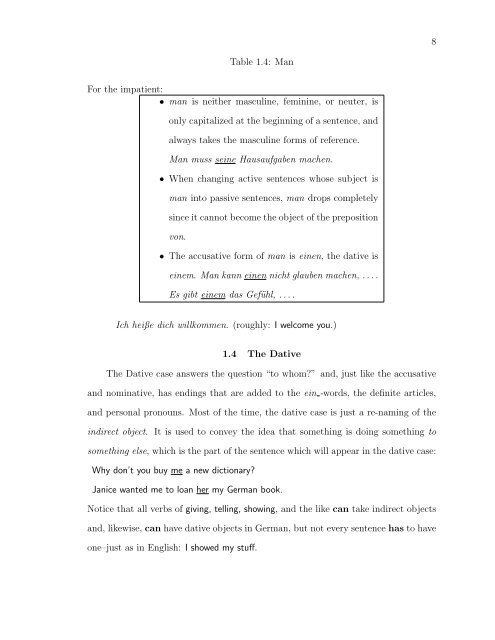an Accompanying Guide to Any First-Year German Course
an Accompanying Guide to Any First-Year German Course
an Accompanying Guide to Any First-Year German Course
You also want an ePaper? Increase the reach of your titles
YUMPU automatically turns print PDFs into web optimized ePapers that Google loves.
8<br />
Table 1.4: M<strong>an</strong><br />
For the impatient:<br />
• m<strong>an</strong> is neither masculine, feminine, or neuter, is<br />
only capitalized at the beginning of a sentence, <strong>an</strong>d<br />
always takes the masculine forms of reference.<br />
M<strong>an</strong> muss seine Hausaufgaben machen.<br />
• When ch<strong>an</strong>ging active sentences whose subject is<br />
m<strong>an</strong> in<strong>to</strong> passive sentences, m<strong>an</strong> drops completely<br />
since it c<strong>an</strong>not become the object of the preposition<br />
von.<br />
• The accusative form of m<strong>an</strong> is einen, the dative is<br />
einem. M<strong>an</strong> k<strong>an</strong>n einen nicht glauben machen, . . . .<br />
Es gibt einem das Gefühl, . . . .<br />
Ich heiße dich willkommen. (roughly: I welcome you.)<br />
1.4 The Dative<br />
The Dative case <strong>an</strong>swers the question “<strong>to</strong> whom?” <strong>an</strong>d, just like the accusative<br />
<strong>an</strong>d nominative, has endings that are added <strong>to</strong> the ein -words, the definite articles,<br />
<strong>an</strong>d personal pronouns. Most of the time, the dative case is just a re-naming of the<br />
indirect object. It is used <strong>to</strong> convey the idea that something is doing something <strong>to</strong><br />
something else, which is the part of the sentence which will appear in the dative case:<br />
Why don’t you buy me a new dictionary?<br />
J<strong>an</strong>ice w<strong>an</strong>ted me <strong>to</strong> lo<strong>an</strong> her my Germ<strong>an</strong> book.<br />
Notice that all verbs of giving, telling, showing, <strong>an</strong>d the like c<strong>an</strong> take indirect objects<br />
<strong>an</strong>d, likewise, c<strong>an</strong> have dative objects in Germ<strong>an</strong>, but not every sentence has <strong>to</strong> have<br />
one–just as in English: I showed my stuff.
















